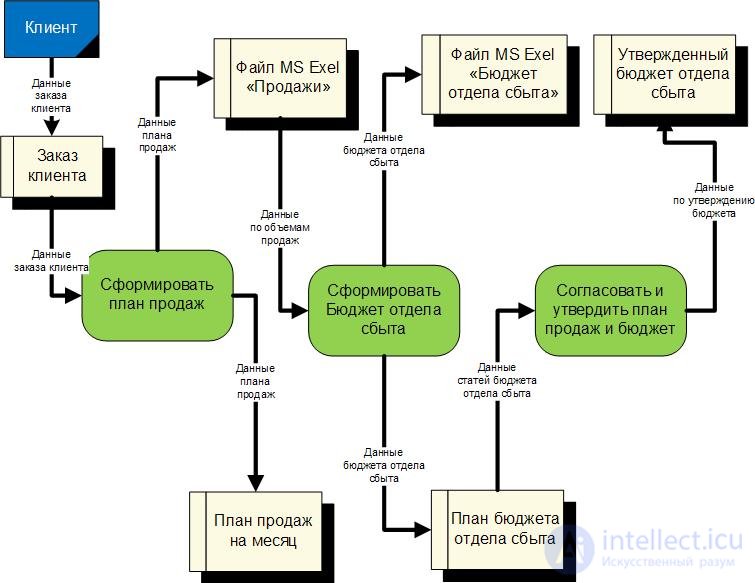Lecture
One of the most important ways to describe the process is the DFD (Data Flow Diagram) data flow diagrams. Such diagrams contain, as a rule, two types of graphic objects: quadrangles and arrows. The first describe the functions (works, processes), the second - the data flows between these functions. The simplest process diagram in the DFD format is shown below.

On a DFD diagram, functions are usually arranged from left to right in the order corresponding to the sequence of their execution in time, although this is not mandatory. If you adhere to this requirement, the resulting scheme is a description of the process, which is similar to the description of the process in IDEF3 notation. Typical decomposition rules are applicable to the description of processes in DFD. As for the sides of quadrilaterals, in the DFD notation they do not have that meaning as in IDEF0.
Often the DFD notation is confused with a simple description of the flow of information between departments. This is not the same thing. Why it is impossible to consider a simple description of flows between divisions of an organization as a process diagram? In each large division (for example, the sales department of a large enterprise), various business processes are carried out. Often these processes have different internal and external clients. That is why the scheme of information flows between departments, describes only the data flows that cross the boundaries of departments, but does not contain all the information about external and internal changes in the information flow. That is, the DFD diagram contains steps for modifying / changing information from one action to another. In this case, the description of the flow of information between departments is practically important and widely used tool.
An example of a process description in DFD can be complicated using the concept of “data warehouse”. This means any storage medium, for example, a paper document, an electronic file, an industrial database on an organization’s server, etc. When building a process model using data warehouses, it must be remembered that the data (information) cannot be moved between the functions of the process by themselves. They can be transferred only through certain intermediaries - carriers of information or, which is the same, data storages. Below is a process model in the DFD notation, built using the concept of “data warehouse”.

What are the DFD notations for? First of all, they are needed to describe the actual data flows in the organization. Descriptions can be created both by process and by function. In the first case, we obtain business process models in the DFD format, in the second, a data exchange scheme between departments. The created models of data flows of the organization can be used in solving such tasks as:
It should be noted that the DFD notation can be effectively applied to describe document flows or material resource flows.
Moreover, the DFD notation can be somewhat modernized so that both data flows and material resource flows can be shown in one diagram.

In practice, when creating process models, it is often useful to use several methods of description. First, for example, we create a model in the IDEF0 notation, identify the functions included in the process. Then we decompose the process. When a certain level of detail (three or four) is reached, it becomes advisable to form several schemes for each detailed process in various formats: control is IDEF0, and data and materials flows are in DFD.
Comments
To leave a comment
Analysis and reengineering of business processes
Terms: Analysis and reengineering of business processes